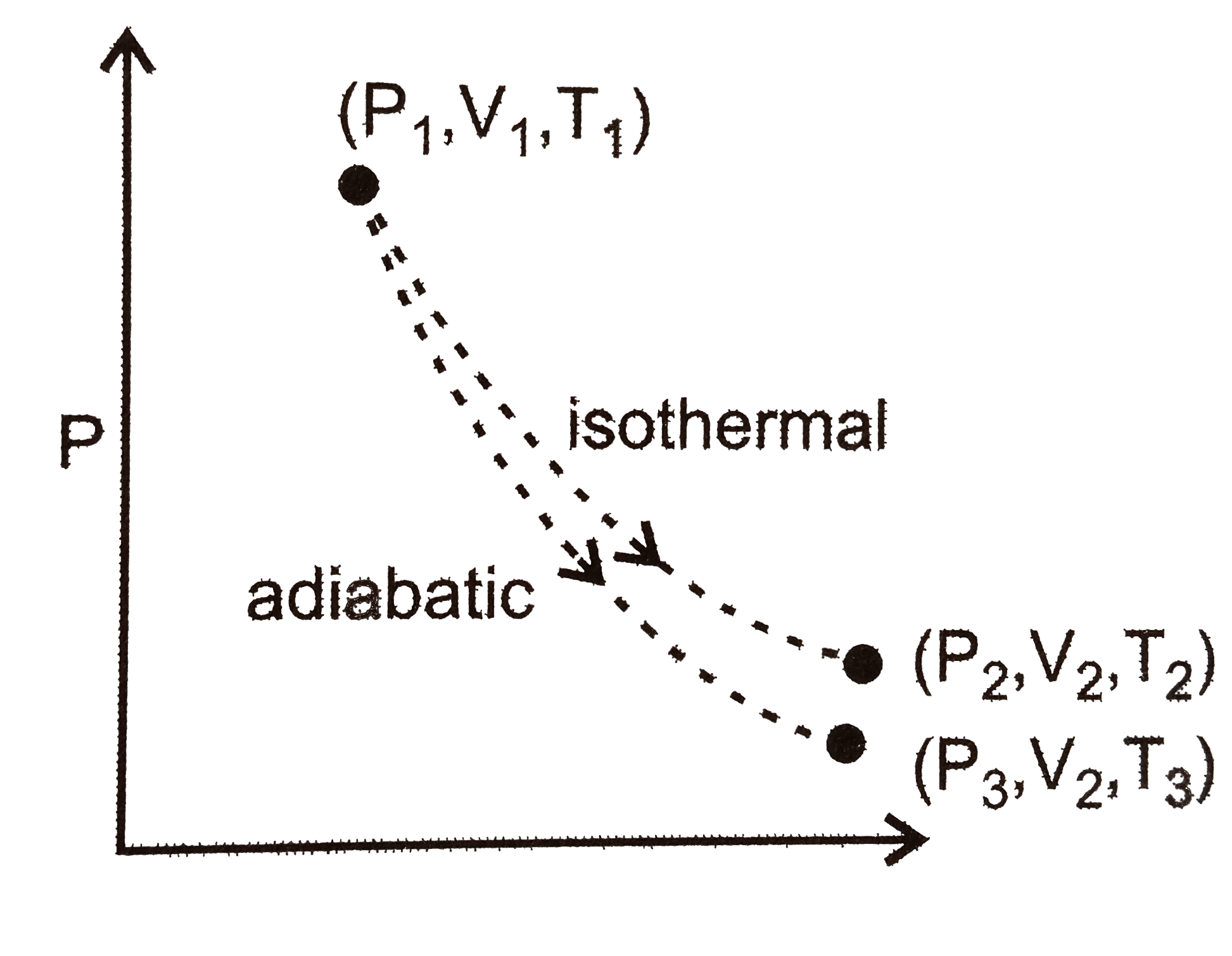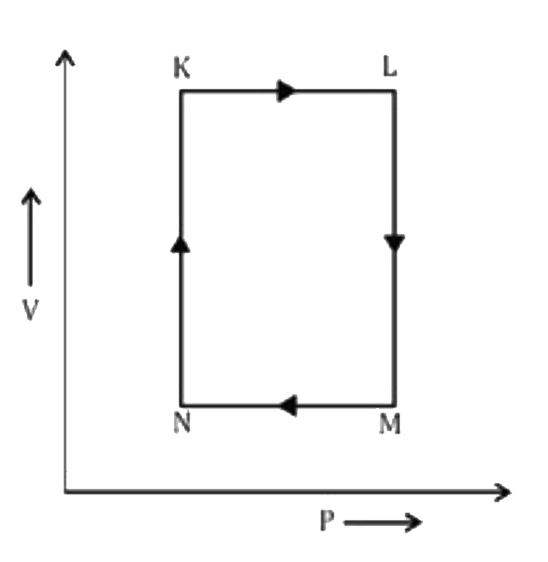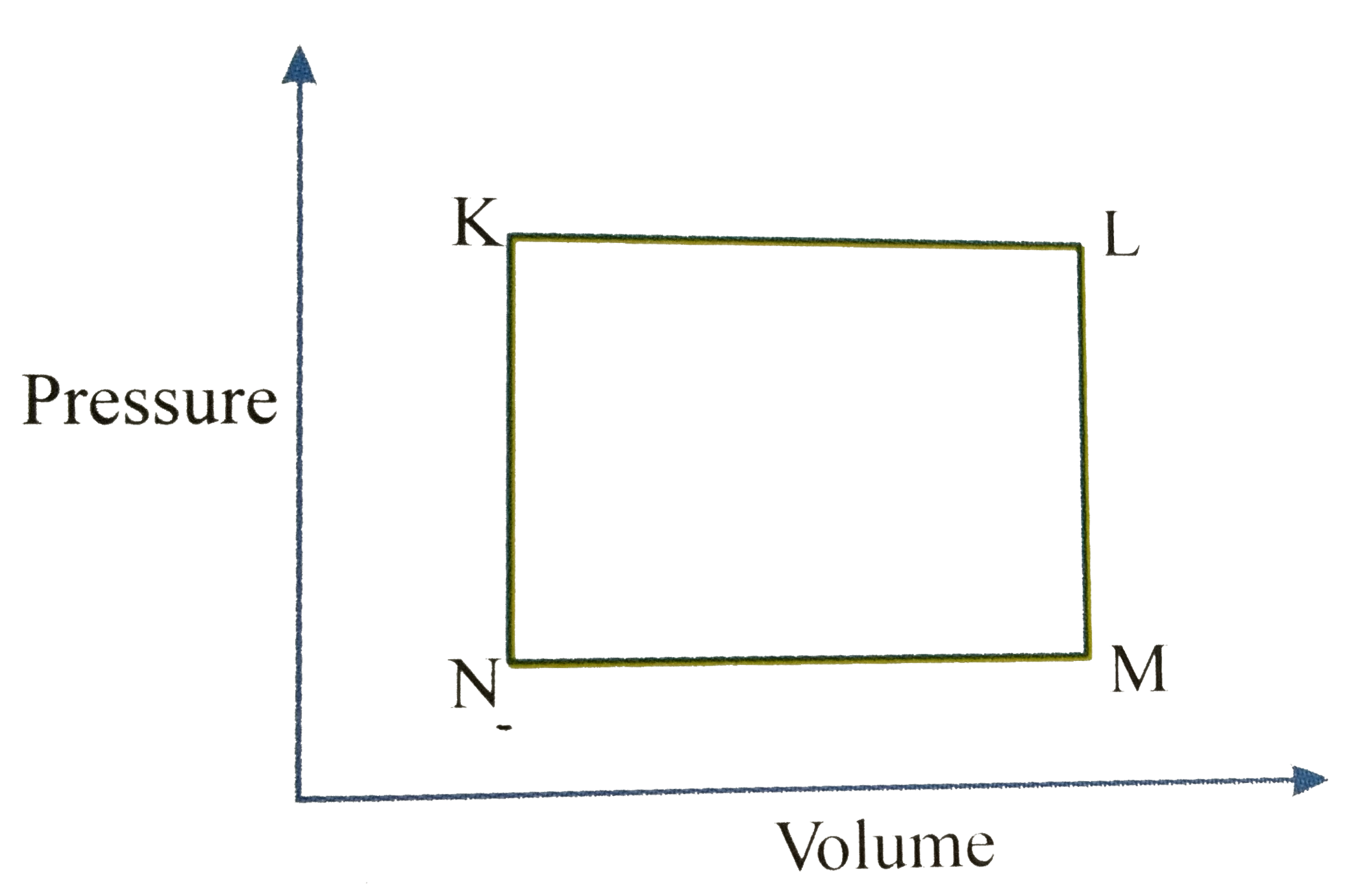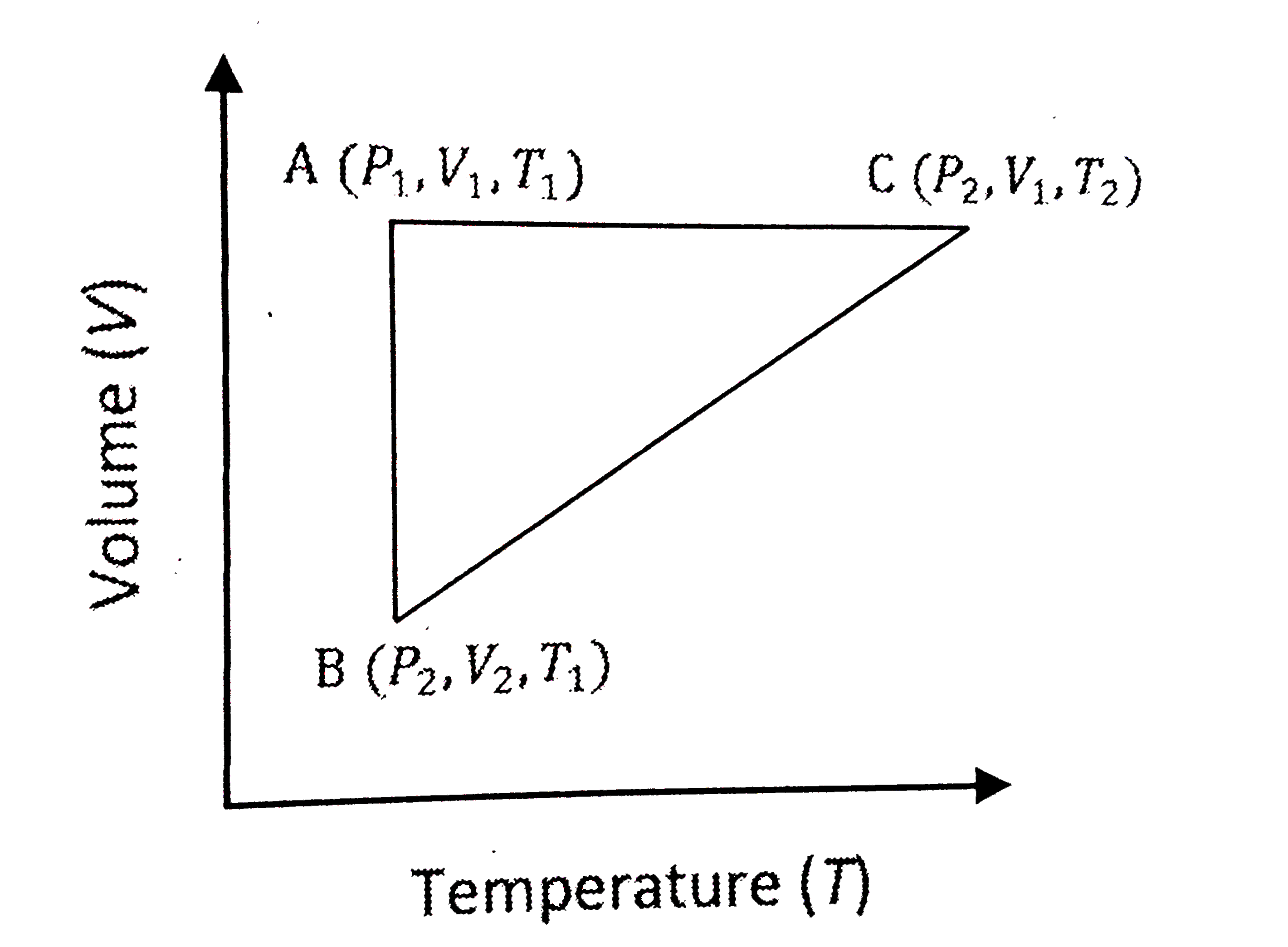JEE section (Reasoning type questions) from UNIVERSAL BOOK DEPOT 1960 CHEMISTRY (HINGLISH) THERMODYNAMICS AND THERMOCHEMISTRY for Class 12
| Class 12 | CHEMISTRY |
| Chapter | THERMODYNAMICS AND THERMOCHEMISTRY |
| UNIVERSAL BOOK DEPOT 1960 CHEMISTRY (HINGLISH) | JEE section (Reasoning type questions) |
| Medium | English |
| Academic Year | 2023-2024 |
Question 25
For the reaction, 2CO+O2→2CO2,ΔH=−560kJ. Two moles of CO and one mole of O2 are taken in a container of volume 1 L. They completely form two moles of CO2, the gases deviate appreciably from ideal behaviour. If the pressure in the vessel changes from 70 to 40 atm, find the magnitude (absolute value) of ΔU at 500 K. View SolutionQuestion 41
The standard state Gibbs free energies of formation of ) C(graphite and C(diamond) at T = 298 K are
ΔfG∘[C(graphite)]=0kJmol−1
ΔfG∘[C(diamond)]=2.9kJmol−1
The standard state means that the pressure should be 1 bar, and substance should be pure at a given temperature. The conversion of graphite [ ) C(graphite ] to diamond [C(diamond)] reduces its volume by 2×10−6m3mol−1. If ) C(graphite is converted to C(diamond) isothermally at T = 298 K, the pressure at which ) C(graphite is in equilibrium with C(diamond), is
[Useful information:1J=1kgm2s−2,1Pa=1kgm−1s−2,1bar=105Pa]View SolutionQuestion 50
For an ideal gas, consider only P−V work in going from an initial state X to the final state Z. The final state Z can be reached by either of the two paths shown in the figure. Which of the following choice(s) is (are) correct? [Take ΔS as change in entropy and w as work done]
 View Solution
View SolutionQuestion 52
An ideal gas in a thermally insulated vessel at internal pressure = P1, volume = V1 and absolute temperature = T1 expands irreversibly against zero external pressure, as shown in the diagram. The final internal pressure, volume and absolute temperature of the gas are P2,V2 and T2, respectively. For this expansion.
 View Solution
View SolutionQuestion 56
If separate samples of argon, methane, nitrogen and ammonia, all at the same initial temperature and pressure and expanded adiabatically to double their original volumes, then which one of these gases will require the greatest quantity of heat to restore the original temperature?View SolutionQuestion 58
Assertion (A): The endothermic reactions are favoured at lower temperature and the exothermic reactions are favoured at higher temperature.
Reason (R ) : when a system in equilibrium is disturbed by changing the temperature, it will tend to adjust itself so as to overcome the effect of the change. View SolutionQuestion 66
When 100 mL of 1.0 M HCl was mixed 100 mL of 1.0 M NaOH in an insulated beaker at constant pressure, a temperature increase 5.7∘C was measured for the beaker and its contents (Expt. 1). Because the enthalpy of neutralization of a strong acid with a strong base is a constant (−57.0kJmol−1), this experiment could be used to measure the calorimeter constant. In a second experiment (Expt.2) 100 mL of 2.0 M acetic acid (Ka=2.0×10−5) was mixed with 100 mL of 1.0 M NaOH (under indentical conditions to Expt. 1) where a temperature rise of 5.6∘C was measured
(Consider heat capacity of all solutions as 4.2Jg−1K−1 and density of al solutions as 1.0 gmL−1)
Enthalpy of dissociation (in KJmol−1) of acetic acid obtained from the Expt.2 isView SolutionQuestion 67
When 100 mL of 1.0 M HCl was mixed 100 mL of 1.0 M NaOH in an insulated beaker at constant pressure, a temperature increase 5.7∘C was measured for the beaker and its contents (Expt. 1). Because the enthalpy of neutralization of a strong acid with a strong base is a constant (−57.0kJmol−1), this experiment could be used to measure the calorimeter constant. In a second experiment (Expt.2) 100 mL of 2.0 M acetic acid (Ka=2.0×10−5) was mixed with 100 mL of 1.0 M NaOH (under indentical conditions to Expt. 1) where a temperature rise of 5.6∘C was measured
(Consider heat capacity of all solutions as 4.2Jg−1K−1 and density of al solutions as 1.0 gmL−1)
The pH of the solution after Expt. 2 is View SolutionQuestion 68
Standard Gibb's energy of reaction (ΔrG∘) at a certain temperature can be computed as ΔrG∘=ΔrH∘−T.ΔrS∘ and the change in the value of ΔrH∘ and ΔrS∘ for a reaction with temperature can be computed as follows
ΔrH∘T2−ΔrH∘T1=ΔrC∘p(T2−T1)
ΔrS∘T2−ΔrS∘T1=ΔrC∘pln(T2T1)
ΔrG∘=ΔrH∘−T.ΔrS∘
and by ΔrG∘=−RTlnKeq
Consider the following reaction :
CO(g)+2H2(g)⊂CH3OH(g)
Given : ΔfH∘(CH3OH),g=−201kJ/mol
ΔfH∘(CO,g)=−114kJ/mol
S∘(CH3OH,g)=240J/K−mol,S∘(H2,g)=29JK−1mol−1
S∘(CO,g)=198J/mol−K,C∘p,m(H2)=28.8J/mol−K
C∘p,m(CO)=29.4J/mol−K,C∘p,m(CH3OH)=44J/mol−K
and ln(320300)0.06, all data at 300 K
ΔrS∘ at 320 K is View SolutionQuestion 69
Standard Gibb's energy of reaction (ΔrG∘) at a certain temperature can be computed as ΔrG∘=ΔrH∘−T.ΔrS∘ and the change in the value of ΔrH∘ and ΔrS∘ for a reaction with temperature can be computed as follows
ΔrH∘T2−ΔrH∘T1=ΔrC∘p(T2−T1)
ΔrS∘T2−ΔrS∘T1=ΔrC∘pln(T2T1)
ΔrG∘=ΔrH∘−T.ΔrS∘
and by ΔrG∘=−RTlnKeq
Consider the following reaction :
CO(g)+2H2(g)⊂CH3OH(g)
Given : ΔfH∘(CH3OH),g=−201kJ/mol
ΔfH∘(CO,g)=−114kJ/mol
S∘(CH3OH,g)=240J/K−mol,S∘(H2,g)=29JK−1mol−1
S∘(CO,g)=198J/mol−K,C∘p,m(H2)=28.8J/mol−K
C∘p,m(CO)=29.4J/mol−K,C∘p,m(CH3OH)=44J/mol−K
and ln(320300)0.06, all data at 300 K
ΔrS∘ at 300 K for the reaction is View SolutionQuestion 70
Standard Gibb's energy of reaction (ΔrG∘) at a certain temperature can be computed as ΔrG∘=ΔrH∘−T.ΔrS∘ and the change in the value of ΔrH∘ and ΔrS∘ for a reaction with temperature can be computed as follows
ΔrH∘T2−ΔrH∘T1=ΔrC∘p(T2−T1)
ΔrS∘T2−ΔrS∘T1=ΔrC∘pln(T2T1)
ΔrG∘=ΔrH∘−T.ΔrS∘
and by ΔrG∘=−RTlnKeq
Consider the following reaction :
CO(g)+2H2(g)⊂CH3OH(g)
Given : ΔfH∘(CH3OH),g=−201kJ/mol
ΔfH∘(CO,g)=−114kJ/mol
S∘(CH3OH,g)=240J/K−mol,S∘(H2,g)=29JK−1mol−1
S∘(CO,g)=198J/mol−K,C∘p,m(H2)=28.8J/mol−K
C∘p,m(CO)=29.4J/mol−K,C∘p,m(CH3OH)=44J/mol−K
and ln(320300)0.06, all data at 300 K
ΔrH∘ at 320 K is View SolutionQuestion 71
Standard Gibb's energy of reaction (ΔrG∘) at a certain temperature can be computed as ΔrG∘=ΔrH∘−T.ΔrS∘ and the change in the value of ΔrH∘ and ΔrS∘ for a reaction with temperature can be computed as follows
ΔrH∘T2−ΔrH∘T1=ΔrC∘p(T2−T1)
ΔrS∘T2−ΔrS∘T1=ΔrC∘pln(T2T1)
ΔrG∘=ΔrH∘−T.ΔrS∘
and by ΔrG∘=−RTlnKeq
Consider the following reaction :
CO(g)+2H2(g)⊂CH3OH(g)
Given : ΔfH∘(CH3OH),g=−201kJ/mol
ΔfH∘(CO,g)=−114kJ/mol
S∘(CH3OH,g)=240J/K−mol,S∘(H2,g)=29JK−1mol−1
S∘(CO,g)=198J/mol−K,C∘p,m(H2)=28.8J/mol−K
C∘p,m(CO)=29.4J/mol−K,C∘p,m(CH3OH)=44J/mol−K
and ln(320300)0.06, all data at 300 K
ΔrH∘ at 300 K for the reaction is View SolutionQuestion 72
Standard Gibb's energy of reaction (ΔrG∘) at a certain temperature can be computed as ΔrG∘=ΔrH∘−T.ΔrS∘ and the change in the value of ΔrH∘ and ΔrS∘ for a reaction with temperature can be computed as follows
ΔrH∘T2−ΔrH∘T1=ΔrC∘p(T2−T1)
ΔrS∘T2−ΔrS∘T1=ΔrC∘pln(T2T1)
ΔrG∘=ΔrH∘−T.ΔrS∘
and by ΔrG∘=−RTlnKeq
Consider the following reaction :
CO(g)+2H2(g)⊂CH3OH(g)
Given : ΔfH∘(CH3OH),g=−201kJ/mol
ΔfH∘(CO,g)=−114kJ/mol
S∘(CH3OH,g)=240J/K−mol,S∘(H2,g)=29JK−1mol−1
S∘(CO,g)=198J/mol−K,C∘p,m(H2)=28.8J/mol−K
C∘p,m(CO)=29.4J/mol−K,C∘p,m(CH3OH)=44J/mol−K
and ln(320300)0.06, all data at 300 K
ΔrG∘ at 320 K is View SolutionQuestion 73
In a constant volume calorimeter, 3.5g of a gas with molecular weight 28 was burnt in excess oxygen at 298.0K. The temperature of the calorimeter was found to increase from 298.0K→298.45K due to the combustion process. Given that the heat capacity of the calorimeter is 2.5kJK−1, find the numerical value for the enthalpy of combustion of the gas in kJmol−1View SolutionQuestion 74
One mole of an ideal gas is taken from a to b along two paths denoted by the solid and the dashed lines as shown In the graph below. If the work done along the solid line path is Ws and that along the the dotted line path is wd, then the integer closest to the ratio wd/ws is
 View Solution
View SolutionQuestion 79
Match the thermodynamic processes given under Column I with the expressions given under Column II
Column IColumn II(A)Freezing of water at 273 K and 1 atm(p)q=0(B)Expansion of 1 mole of an ideal gas into a vacuum under isolated conditions(q)w=0(C)Mixing of equal volumes of two ideal gases at constant temperature and pressure in an isolated container(r)ΔSsys<0(D)Reversible heating of H2(g) at 1 atm from 300 K to 600 K, followed by reversible cooling to 300 K at 1 atm(s)ΔU=0(t)ΔG=0View SolutionQuestion 80
Match the entries listed in Column I with appropriate entries listed in Column II.
Column IColumn II(A)Hess' law(p)2.303log.P2P1=ΔvapHR(T2−T1T1T2)(B)Combustion reaction(q)ΔvapH=88JK−1mol−1×Boiling point in Kelvin(C)Trouton's law(r)Exothermic(D)Clausius-Cal-peyron equation(s)ΔH remains the same irrespective stepsView SolutionQuestion 83
For a reaction A P, the plots of [A] and [P] with time at temperature T1 and T2 are given below

If T2>T1, the correct statement(s) is (are)
(Assume ΔHθ and ΔStheat are independent of temperature and ratio of lnK at T1 to InK at T2 is greater than T2/T1. Here H, S, G and K are enthalpy, entropy, Gibbs energy and equilibrium constant, respectively.)View SolutionQuestion 84
The surface of copper gets tarnished by the formation of copper oxide. N2 gas was passed to prevent the oxide formation during heating of copper at 1250 K. However, the N2 gas contains 1 mole % of water vapour as impurity. The water vapour oxidises copper as per the reaction given below: 2Cu(s)+H2O(g)→Cu2O(s)+H2(g) is the minimum partial pressure of H2 (in bar) needed to prevent the oxidation at 1250 K. The value of ln is ____. (Given: total pressure = 1 bar, R (universal gas constant) = 8JK−1mol−1,ln(10)=2.3.Cu(s)andCu2O(s) are mutually immiscible. At 1250 K:2Cu(s)+1/2O2(g)→Cu2O(s)
△Hθ=−78,000Jmol−1
H2(g)+1/2O2(g)→H2O(g),△Gθ=−1,78,000Jmol−1, G is the Gibbs energy View SolutionQuestion 85
Consider the following reversible reaction, AgBg→ABg . The activation energy of the backward reaction exceeds that of the forward reaction by 2(∈Jmol1). If the pre-exponential factor of the forward reaction is 4 times that of the reverse reaction, the absolute value of△Gθ(∈Jmol−1) for the reaction at 300 K is ____. (Given, ln(2) = 0.7,=2500Jmol−1 at 300 K and G is the Gibbs energy)View Solution
All Exercises from UNIVERSAL BOOK DEPOT 1960 CHEMISTRY (HINGLISH) Class 12 CHEMISTRY THERMODYNAMICS AND THERMOCHEMISTRY
- ORDINARY THINKING (OBJECTIVE QUESTIONS) BOND ENERGY
- ORDINARY THINKING (OBJECTIVE QUESTIONS) FREE ENERGY AND WORK FUNCTION
- ORDINARY THINKING (OBJECTIVE QUESTIONS) HEAT OF REACTION
- ORDINARY THINKING (OBJECTIVE QUESTIONS) `II^(ND) & `III^(RD)` LAW OF THERMODYNAMICS AND ENTROPY
- ORDINARY THINKING (OBJECTIVE QUESTIONS) BASIC CONCEPTS
- ORDINARY THINKING (OBJECTIVE QUESTIONS) FIRST LAW OF THERMODYNAMICS AND HESS LAW
- CRITICAL THINKING (OBJECTIVE QUESTIONS)
- JEE SECTION (COMPREHENSION TYPE QUESTIONS)
- JEE SECTION (INTEGER TYPE QUESTIONS)
- JEE SECTION (JEE (ADVANCED) 2018) MORE THAN ONE CHOICE CORRECT ANSWER
- JEE SECTION (JEE (ADVANCED) 2018) NUMERIC ANSWER TYPE QUESTIONS
- JEE SECTION (MATRIX MATCH TYPE QUESTIONS)
- JEE SECTION (MORE THAN ONE CHOICE CORRECT ANSWER)
- JEE SECTION (ONLY ONE CORRECT ANSWER)
- JEE SECTION (REASONING TYPE QUESTIONS)





